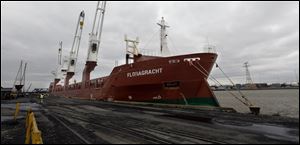
Toledo port sees increase in cargo tonnage
1/15/2018Rebounding iron ore traffic led a nearly 16 percent increase in cargo tonnage through the Port of Toledo during 2017, and a port official said this year’s expected groundbreaking for a new iron smelter near the port should boost that cargo further in future years.
Robust aluminum shipments gave the port’s general and miscellaneous cargo sector the second highest percentage increase in the year-over-year statistics posted last week by the Toledo-Lucas County Port Authority.
Iron ore shipments across CSX Transportation’s Lakefront Dock totaled 3,417,862 tons during 2017, more than double the 1,629,927 tons through that facility the year before. That accounted for more than 35 percent of all cargo across the local docks last year by weight.
Blade Briefing: Port Authority sees 16 percent jump
The total cargo of 9,619,723 tons marked a 15.88 percent increase over 2016, but it was still more than 2 million tons shy of the port’s recent peak in 2014, when iron-ore traffic was even higher and coal business also was stronger than it was last year.
For now, all iron ore through Toledo goes to AK Steel blast furnaces in Middletown, Ohio, and for substantial parts of 2015 and 2016 that steel mill received a significant part of its raw material from an iron processor in northwest Indiana. But the Indiana plant closed late last year, pushing all of AK’s iron-ore supply chain back through the Toledo port.
The new Cliffs Natural Resources Inc. plant planned for the former Gulf Oil refinery site on Front Street in East Toledo isn’t scheduled to begin production until 2020, but Joe Cappel, the port authority’s vice president of business development, said it’s expected to consume about 2 million tons of iron ore annually to produce 1.6 million tons of hot-briquetted iron.
While the hot-briquetted iron — used as a raw material by electric-arc mills that make steel by melting concentrated iron and scrap metal rather than using traditional blast furnaces — will leave Toledo in trucks and trains, the ore is expected to arrive from mining regions entirely aboard lake ships.
Coal, historically Toledo’s heaviest-volume cargo, fell back into second place last year behind iron ore as it declined by just over 200,000 tons.
As always, general and miscellaneous cargo was the smallest sector by weight, but it’s prized by the port authority because of the dockworker jobs and revenue it yields.

A ship docked in Toledo's port.
Toledo’s standing as a London Metals Exchange delivery point for aluminum continued to produce traffic last year, with about 236,000 tons of the metal arriving by barge from a smelter in eastern Quebec.
“Every year it continues to grow,” Mr. Cappel said. “And the more you handle something, the better you get at it.”
The bulk of the remaining 60,000 tons of general cargo was made up of machinery and other “project cargo,” steel, and bagged minerals including cement, salt, and calcium nitrate.
Mr. Cappel said winter weather’s abrupt onset in late December could bring a burst of shipping activity at the 2018 shipping season’s start.
“People may be trying to catch up with shipments they missed out on at the end of this year,” he said.
Grain in particular often has a late-season rush following the fall harvest.
Grain traffic through Toledo fell by a little more than 24 percent during 2017, and Mr. Cappel said that was largely because of “pretty minimal” corn shipments.
Soybeans “were on par with 2016,” and there were also substantial inbound shipments of wheat and oats, he said, along with canola moving through the Kuhlman Corp. terminal that was “something we hadn’t handled in a few years.”
Contact David Patch at dpatch@theblade.com or 419-724-6094.